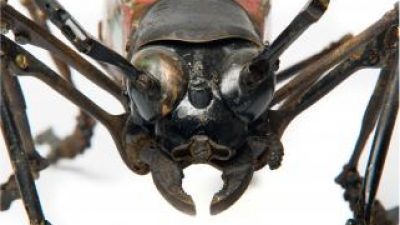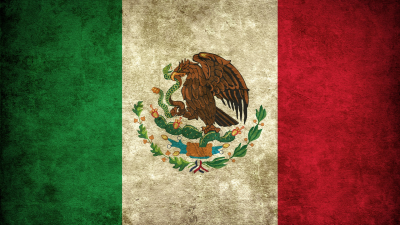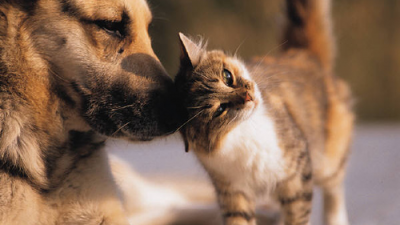Types of monkeys, primates and apes
|
OTHERS
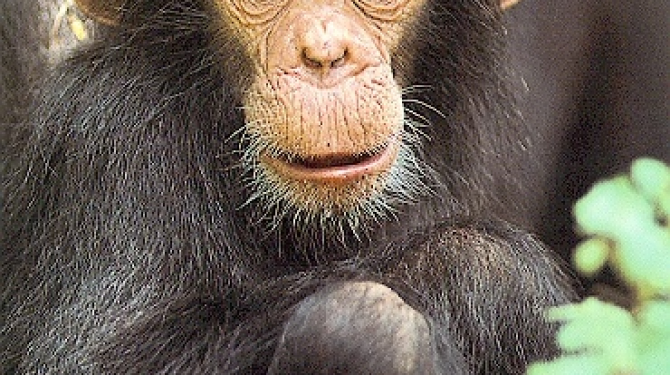
Source: listas.20minutos.es
In this group the great apes and our own species are studied. The orangutan, gorillas and chimpanzees make up the group of great apes. Until not long ago the great apes were assigned to a family and we studied in another family by ourselves. Recent conclusions indicate that in reality our kinship to the great apes is not very distant. It is estimated that our branch separated (radiate) from that of chimpanzees about 6 million years ago. Gorillas radiated about 7 or 8 million years ago and orangutans about 16 million ago. Although it is also very true that in the last 6 million years we have evolved by leaps and bounds.
TOP 20:
TAMARIN
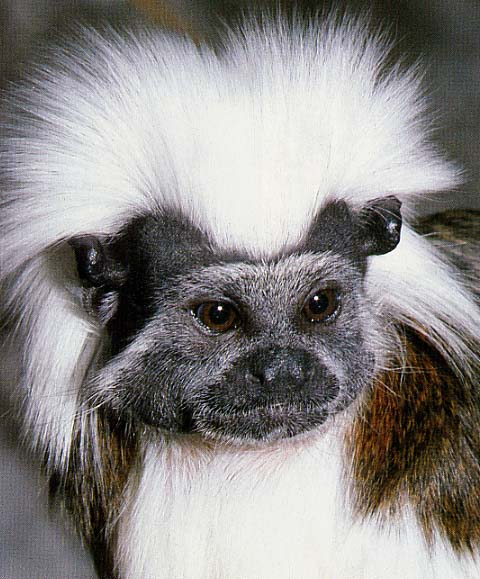
The monkey discovered was first sighted by scientists in 2007 in the Brazilian state of Amazonas and is related to the Tamarín monkeys. The small monkey, which is mostly gray and brown and weighs 213 grams, has been named with the scientific name of Tamarín mura, by the indigenous Mura tribe of the Purus and Madeira river basin, where the new species was found . The specimens of the small monkey are about 24 centimeters tall and have a tail of 32 centimeters. "This new monkey described, shows that even today there are important discoveries of wildlife to be made," said in a statement by WCS Fabio Rohe, principal author of a study, published in the Society for the Conservation of Wildlife (WCS). ) that confirms the new discovery.
TOP 19:
MONO GIBON
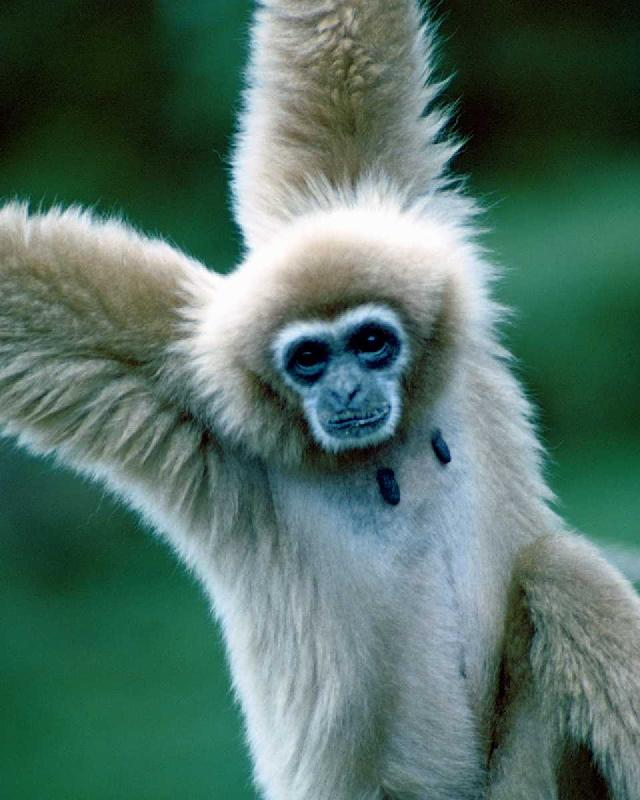
The gibbons, or minor apes, are closely related to humans and great apes. Scientists estimate that they come from the same branch in evolution that radiated, or separated, from that of the great apes about 22 million years ago. The physical aspect of gibbons is very similar to that of monkeys but has no tail. Thanks to their long arms, these primates are extremely agile hanging and jumping among the branches of trees. All the gibbons that exist today are native to Asia. Its distribution extends from India to the islands of Borneo, Sumatra and Java.
TOP 18:
MONO COLOBUS
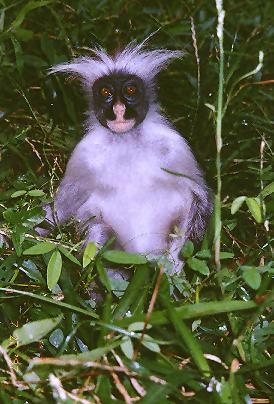
Genus of Old World monkeys, subfamily colobinae, family cercopithecidae, living in the forests of Africa. It consists of eight species: C. angolensis (Angolan colobus), C. badius or C. rufomitratus (red or bay colobo), C. guereza (Guereza colobus or oriental black and white), C. kirkii (Kirk colobus), C. polykomos (colobus king or western black and white), C. satanas (black colobus), and C. verus (olive colobus). Some authors recognize the Procolobo as a separate genus and then the olive colobus is recognized as the species P. verus.
TOP 17:
MONO SIAMING
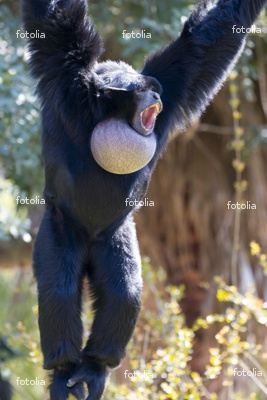
DISTRIBUTION: The Siamang (Hylobates syndactylus) is native to Asia. Its distribution includes the Malay Peninsula and the island of Sumatra. HABITAT: It lives in the rainforests. It is seen in primary and secondary vegetation. SOCIAL STRUCTURE: It is maintained in groups that count from two to ten individuals. ACCESS AREA: They use action areas of 15 to 50 hectares. COMMUNICATION: During the morning it emits high vocal sounds to announce its presence. FOOD: The food consists of leaves, fruits and invertebrates. DESCRIPTION: The weight ranges from 10.0 to 14.7 kg.
TOP 16:
MONO NARIGUDO
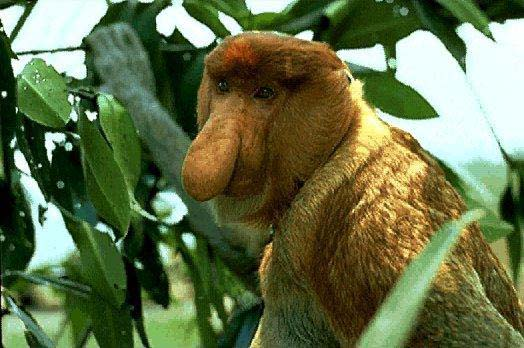
The nostril monkey (Nasalis larvatus) is a species of primate catarrhine of the family Cercopithecidae. It is herbivore and is only found on the island of Borneo, in Southeast Asia. This monkey belongs to the subfamily of Asia langurs, and is the only race of the genus Nasalis. Eat shoots and leaves. He usually travels climbing the trees, but he is also a good swimmer, able to cross deep channels to get food or escape from danger. The loss of its natural habitat, as well as the hunting have caused that this species is in danger of extinction, it is only known of the existence of 7000 specimens.2
TOP 15:
GRAY SQUARE MONKEY
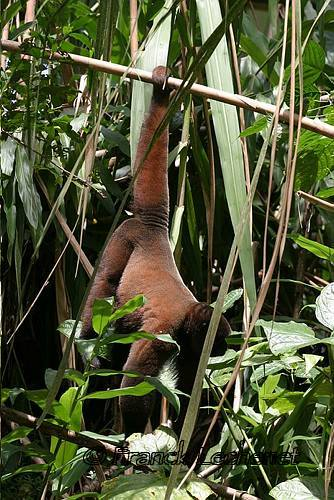
The Gray Woolly Monkey is native to the Americas. Its distribution includes southeastern Venezuela, central and southern Colombia, the Amazon region of Ecuador and Peru, north of Bolivia and west of the Amazon basin of Brazil. It lives in the tropical jungles of primary vegetation. These forests can be found in areas that flood and in areas that do not flood (solid ground). It shows preference to stay in the trees at a height of 16 to 18 meters above the ground. It is documented up to 3000 meters elevation. It is maintained in groups that can count from 5 to 70 individuals. These groups employ action areas of 400 to 1100 hectares. It feeds on fruits. Complement your diet with leaves, flowers, seeds and some animal that you catch. Of length in the body and the head achieves 46 to 65 cm. The tail measures from 53 to 80 cm. The weight is 3.5 and 10 kg.
TOP 14:
WHIRLING MONKEY
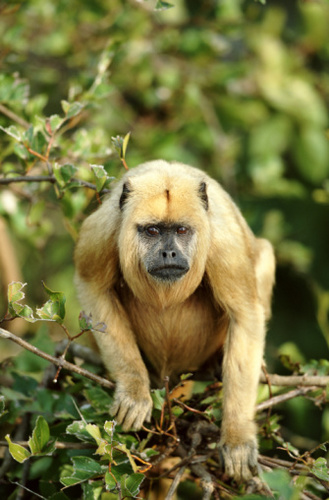
The howler monkey is one of the largest and heaviest monkeys in the New World; They measure between 56 and 92 cm in length, not including the tail, and their weight ranges between 4 and 10 kg. The coat is rough, thick and covers the whole body, except the terminal area of the tail, which is naked in its distal and ventral part. The tail of the howling monkey is used as a prehensile organ and the hair-free area helps the animal to better grip the branches of the trees. They recognize each other very well by their bare, dark-colored face, with a beard of black hair hanging from the neck, a wide lower jaw, and a swollen neck. Hair color varies according to individuals and age, but in general it is yellowish, reddish brown or black.
TOP 13:
LEMUR
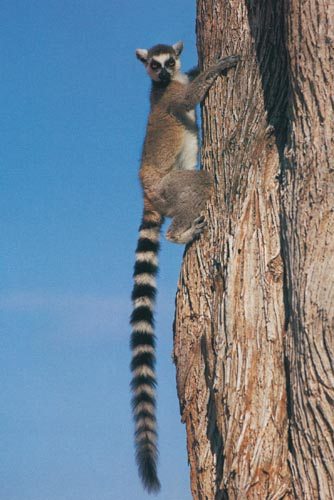
The dorsal parts of the ring-tailed lemur are grayish brown, the ventral parts are whitish and the tail is ringed in black and white. The palms of the hands and the soles of the feet are long, smooth, and leather-like, empower a good grip on slippery rocks, their large foot is considerably smaller than in the other species traditionally classified as Lemur and which are more arboreal, its characteristic feature is its long and bushy tail, is divided into black and white stripes. Adults can reach a body length between 45 and 50 centimeters and a weight of 3.5 kilograms. Their tails are longer than their bodies, measuring up to 56 cm. It has claws on the second finger of its hind limbs which it uses to groom itself. Longevity: The ring-tailed lemur is estimated to have a longevity of about 15 years, although some authors point to 20 years.
TOP 12:
MONO BONOBO
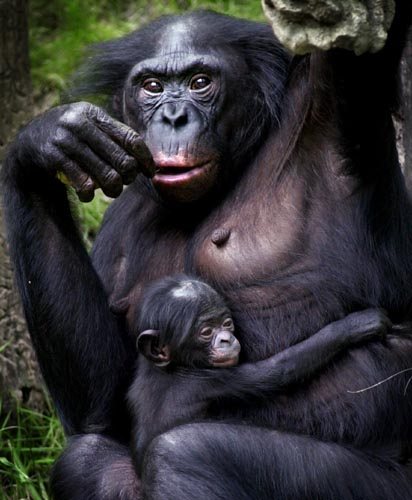
The bonobo (Pan paniscus), also called pygmy chimpanzee (or less frequently graceful chimpanzee or dwarf chimpanzee), is one of the two species that make up the genus of chimpanzees, Pan. The other species of the genus Pan is Pan troglodytes, or common chimpanzee The bonobo was discovered for the first time in 1928, by the American anatomist Harold Coolidge, who presented a skull at the Tervuren museum in Belgium that was believed to belong to a young chimpanzee. However, the merit of the discovery of the bonobo as a differentiated species is attributed to the German Ernst Schwarz, who published the discovery in 1929. The species is distinguished by the tendency for its individuals to be upright at times, due to their matriarchal and egalitarian culture, and for the preponderant role of sexual activity in their society.
TOP 11:
SPIDER MONKEY
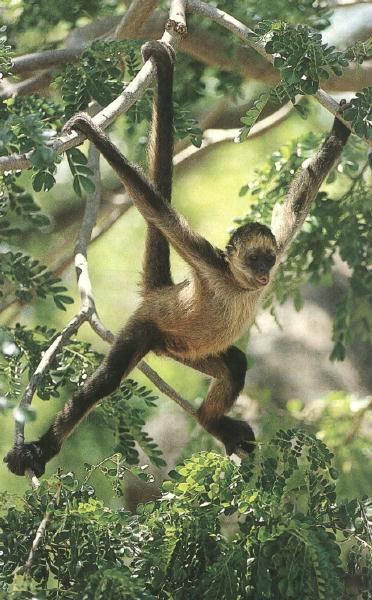
The spider monkey, also called coatá, is the name given to the monkeys of the genus Ateles, characterized by their long limbs and extraordinary agility. The brain of the spider monkey is large and bears some resemblance to that of the superior monkeys of the Old World. The body of the spider monkey is covered by a grayish-yellow, black, brown or brown coat, which is lighter in the lower parts and the eyes are bordered by a white ring that gives them a characteristic appearance.
TOP 10:
MONSTERS TARSEROS
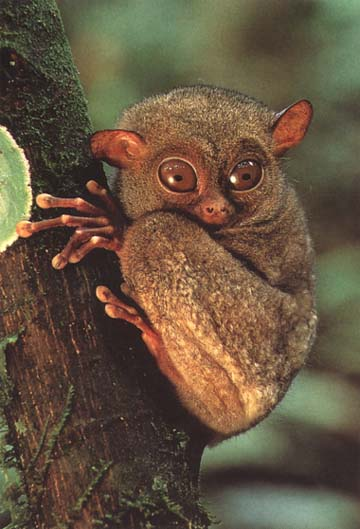
Tarsiers are arboreal primates that live in the forests of Indonesia, Borneo and the Philippine Islands and Celebes. They are small animals, smaller than a rat, hairy and with thin limbs. The fur is grayish-brown and the head is large and round. The tarsero is characterized to have two enormous eyes, because the tarseros are nocturnal animals. The snout is short, and the ears long and rounded. The fingers and toes are very long; also end in a widening that is a kind of adhesive pad that serves the animal to grab the branches and trunks of trees. The tail is long and ends in a tuft of hairs. The hind limbs are very developed; this constitutes an adaptation to the jump, the tarsier's way of moving from one tree to another. Tarsiers feed mostly on insects, lizards and spiders. They are solitary animals and reproduction takes place at any time of the year; the female stops a single calf. The three tarsier species are the Malay tarsier, the Philippine tarsier and the tarsier specter, also called forest spirit, ghost monkey or tarsier of the Celebes.
TOP 9:
MANDRIL
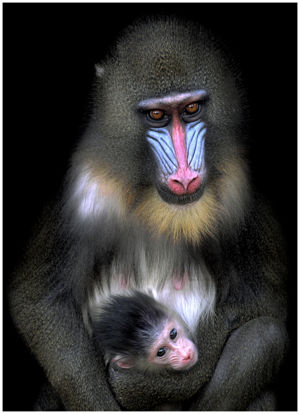
The mandrill (Mandrillus sphinx) is a species of primate catarrhine of the family Cercopithecidae (monkeys of the Old World). The baboon is related to the baboons and more closely with the denim. Mandrill and denim were classified in the past within the genus Papio, but later investigations led to separate them into a genus of their own, Mandrillus. With a weight of up to 55 kg are the largest monkeys in the world (not counting the great apes). Its area of distribution includes the west of the tropical zones of Africa, from Equatorial Guinea to Congo.
TOP 8:
ORANGUTAN
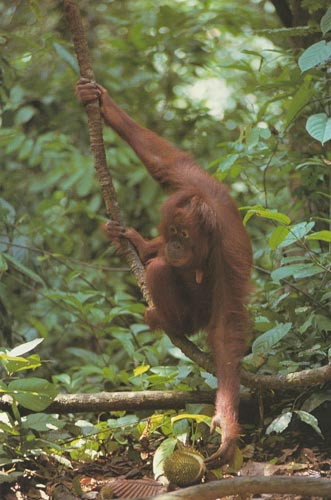
Nutrition function: Primates originated from mammals with mainly insectivorous diets, but at present these can be divided into three dietary groups: frugivores, folivores (that feed on leaves and shoots) and insectivores. However, a species considered as insectivorous does not feed exclusively on arthropods, for example the baby beetle, feeds on insects by 78%, but complements its diet with fruits (18.5%), tree sap (4, 8%) and flower nectar (0.3%). The common chimpanzee, which is usually vegetarian, does not miss the opportunity to hunt other monkeys to obtain a portion of protein. These diets are related to the adaptations in the dentition and intestines that have developed throughout its evolutionary history. Foods in primate habitats vary considerably throughout the year, both in abundance and in distribution, which has an implication on the areas of activity. Usually the folivores have wider areas than the frugivores. For example, the howling monkeys roam in search of food a territory between 4 and 60 km, while frugivorous squirrel monkeys (Saimiri boliviensis) occupy territories between 63 and 130 km, to territories of 250 ha. Reproduction function: It is the females that initiate sexual activity. When they enter their period of fertility or heat, they try to seduce the males, showing off, "flirting" and showing themselves submissive. In that climate of romanticism, there is no male to resist, and after the first physical contacts, they have sex and copulate.
TOP 7:
MACAQUE
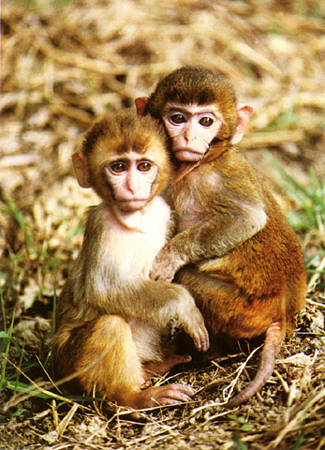
It is a typical macaque, common from Afghanistan to the north of India and southern China. The males grow and reach a height of 60 cm, with a tail of about 30 cm. They present sexual dimorphism; the males can weigh up to 6 kg; the females up to the middle and measure 40 cm. They have a color that varies from brown to gray, with a pink face. They have a life expectancy of about 25 years. There are no known subspecies
TOP 6:
PAPION
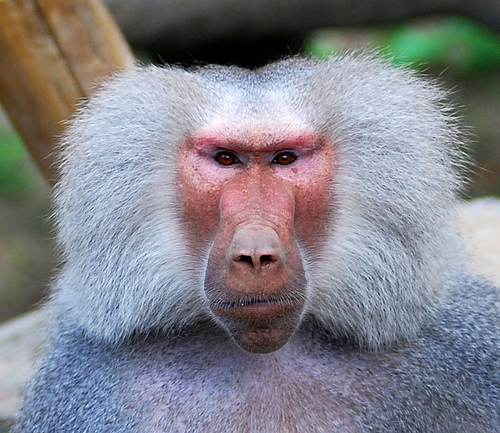
Papion is a genus of catarrhine primates of the family Cercopithecidae vulgarly known as baboons or papiones. However, sometimes this name also extends to the members of the genus Theropithecus such as the gelada and even the mandrill. Overlooking these two monkeys, they are the biggest monkeys of the Old World, the most bulky primates in fact, except for the great apes and the lesser apes.
TOP 5:
CAPPUCCINO
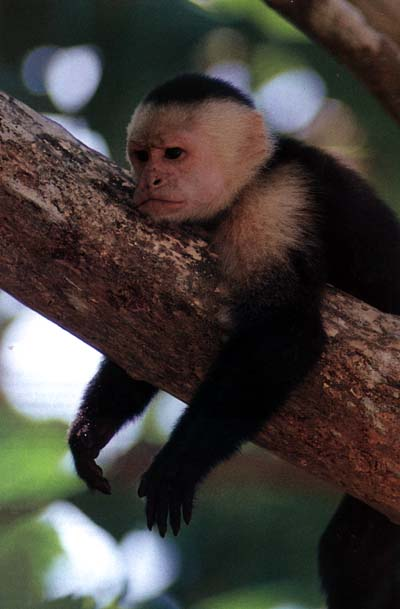
The Capuchin monkeys are members of the Cebus genus of Platyrrhine primates of Central and South America; They owe their name to the Capuchin monks, whose hood has a color similar to the hairs that surround the face of these monkeys. The capuchins are small, typically about 45 cm long, with a prehensile tail that wind around the branches to help in the movement around the trees. It is believed that the Capuchin monkey is the most intelligent of the monkeys of the New World, he likes to explore and when he is observed in captivity, he often reduces to pieces the things he finds. In general the young monkey is lighter than the adult, its tail is the same length as the body. Normally it lives in a herd, so when captive capuchins are released, it is always done as a group.
TOP 4:
SIFAKA
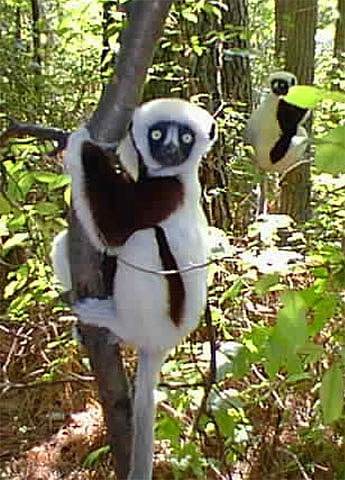
Sifaka is a common name given to two or three species of primates related to lemurs and indris. One of them, the Verreaux sifaka, weighs just under 4 kg and lives in the dry forests of western Madagascar. All of it is of a white tone, with brown or black spots on the head. The second species, the diadem sifaka, weighs about 6.5 kg and lives in the rainforests of eastern Madagascar. The sifakas spend almost all their time in the trees, feeding on leaves throughout the year and fruits when there are. They make spectacular jumps from tree to tree, propelling themselves from the trunk with their long hind limbs and then turning 180 ° in the air to face the next tree. In the course of these jumps, which can be up to 10 m in length, maintain the upright position using the long tail. The athletic ability of the sifaka in the trees contrasts with its clumsy locomotion in the ground. The sifakas are diurnal animals and live in groups of up to 9 individuals, including several females in the breeding phase. In general, each female has a single litter. It has been proven that the Sifakas live in captivity for up to 25 years. Like other lemurs, they are threatened as a result of the destruction of their habitats. Although some populations are relatively stable, others are in danger of immediate extinction.
TOP 3:
GORILLA
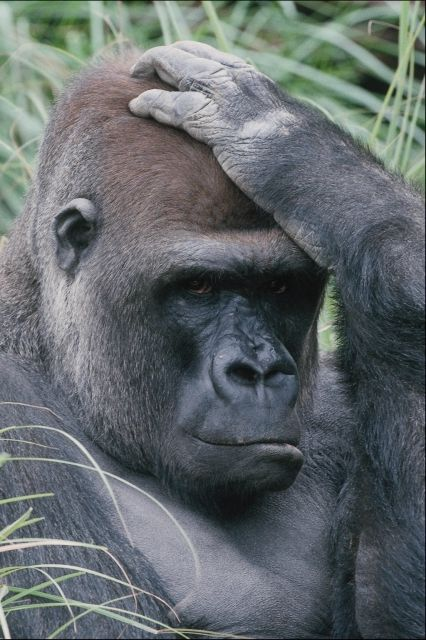
The gorilla lives in Tropical Africa, in the humid forests of the lowlands and mountains. Occasionally they live in bamboo jungles up to 3,500 meters of altitude. Reproduction After a gestation period of eight or nine months, a baby gorilla is born. The young are totally dependent on their mother. They begin to eat vegetable matter at two and a half months. Stop every four years. Nature Despite the fame that the gorilla has, he is among the most gentle and tolerant apes. They walk holding the knuckles of their hands and place the whole sole of the foot on the floor. They communicate through a wide vocabulary, emitting some 22 different sounds. Intelligence The mental capacity of the gorilla continues to be studied today. He is not as curious and excitable as his closest relative, the chimpanzee, although the gorilla shows a greater commitment and a better retentive in the resolution of problems, and is more likely to develop a task devoid of interest than another in which he can get a reward. The gorilla is also able to discriminate some geometric figures from others more effectively than the chimpanzee. After achieving some successes with the chimpanzees, the researchers turned their attention in the mid-1970s to trying to communicate with the gorilla through sign language; A female gorilla came to know and handle more than a hundred words.
TOP 2:
MARMOSET
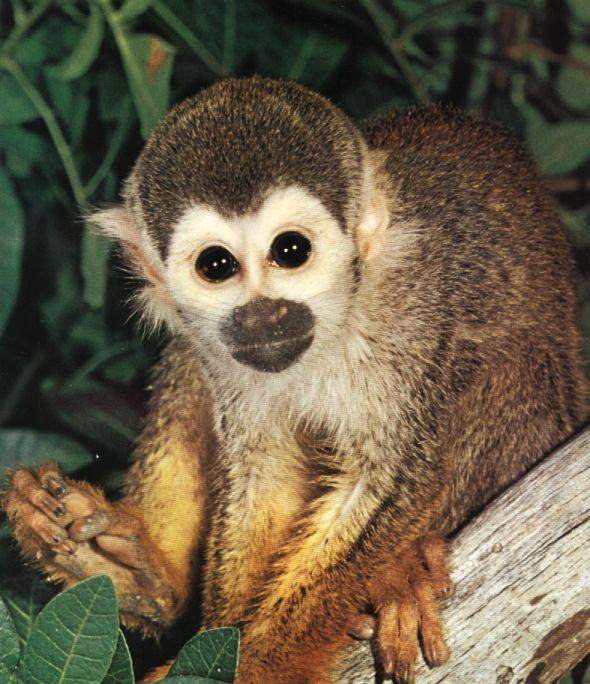
Its body reaches 25 to 30 cm in length and its non-prone tail measures from 35 to 41 cm. It weighs between 300 and 500 g. It has long white mustaches. It lives in hierarchical territorial groups of up to fifteen individuals with an average action area of 30 hectares, sometimes associated with marmosets of other species. They are diurnal and they move with agility great distances, from branch to branch or falling from a higher height. In each group there are at least two males and one female mates with all the males in the group. The gestation period is 140 to 150 days and one or two young that depend on the mother for at least three weeks before acquiring independence. The males help in the rearing by loading the young, which give the mother half an hour, every three hours, for breastfeeding. They feed mainly on fruits and also on nectar, sap, flowers, leaves, insects, small vertebrates and bird eggs.
TOP 1:
CHIMPANZEE
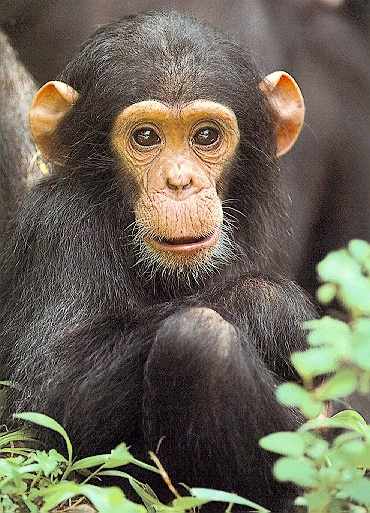
The chimpanzee, simian of equatorial Africa. Because of the physical and genetic structure of the chimpanzee, it is considered the animal most closely related to the human being. There are two species: the common chimpanzee and the bonobo or pygmy chimpanzee. The first is distributed from Sierra Leone and Guinea, on the Atlantic coast, to the Tanganica and Victoria lakes, in the east; the second is found only in the eastern part of the Congo River basin. Scientific Name: Pan troglodytes Family: Hominids Order: Primates Class: Mammals Identification: Robust body, arms longer than the legs, big ears and outs, black fur, small nostrils. Size: Head-body length, 74-96 cm; males higher than females. Weight: Female, 32-47 kg (up to 80 kg in captivity); male, 40-60 kg (up to 90 kg in captivity). Distribution: West and center of equatorial Africa north of the Congo River, from Guinea-Bissau to Ivory Coast, and from Cameroon and Gabon to the Western Great Lakes. Habitat: Humid jungle areas, both plain and mountain, up to 3,000 m altitude, and mosaics or mixed forest and savanna zones. Feeding: Very varied but mainly frugivorous and insectivorous; sometimes it includes leaves and, whenever the occasion arises, small or medium mammals. Reproduction: One young per litter after 200-260 days of gestation (230 as average).







